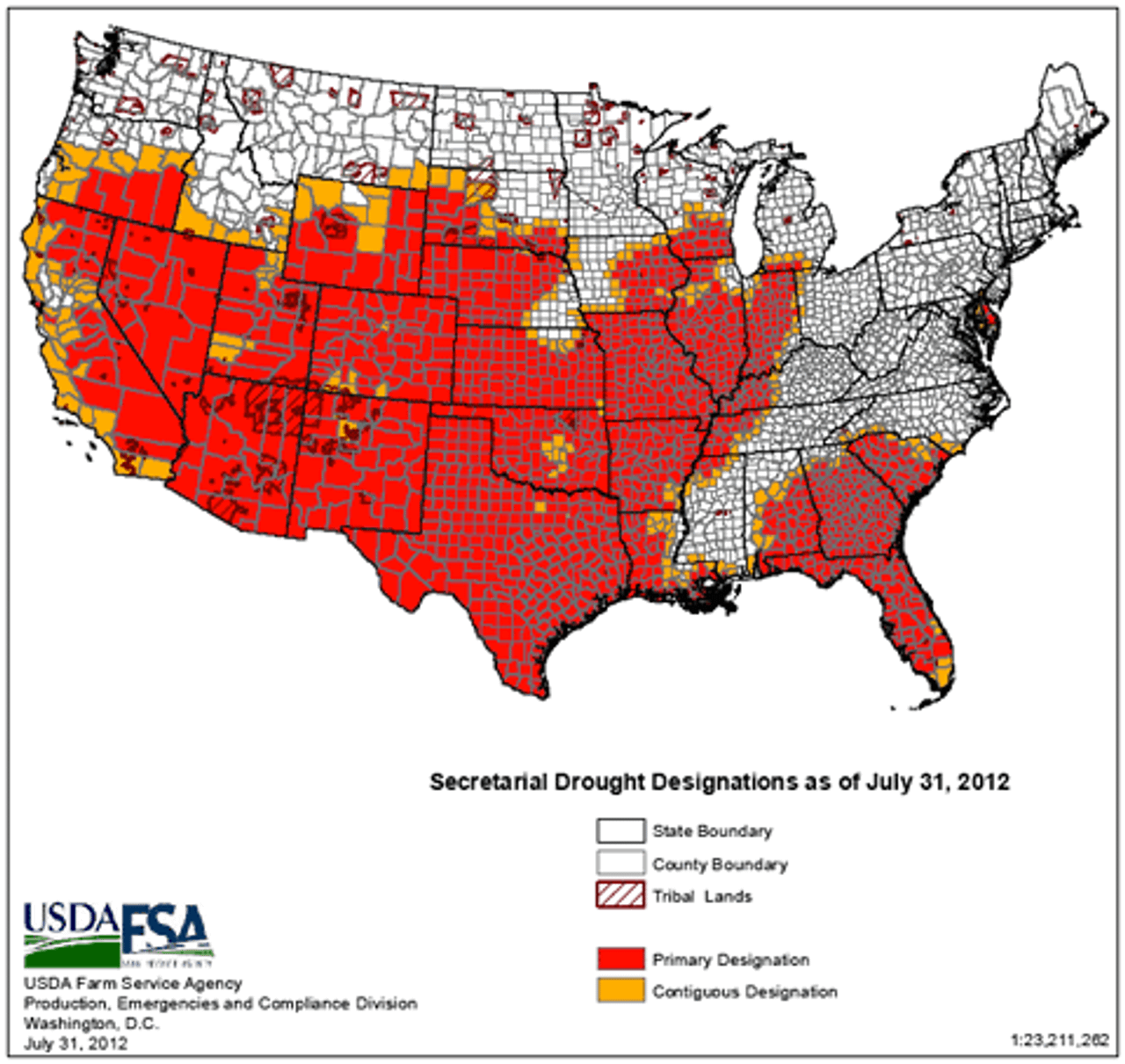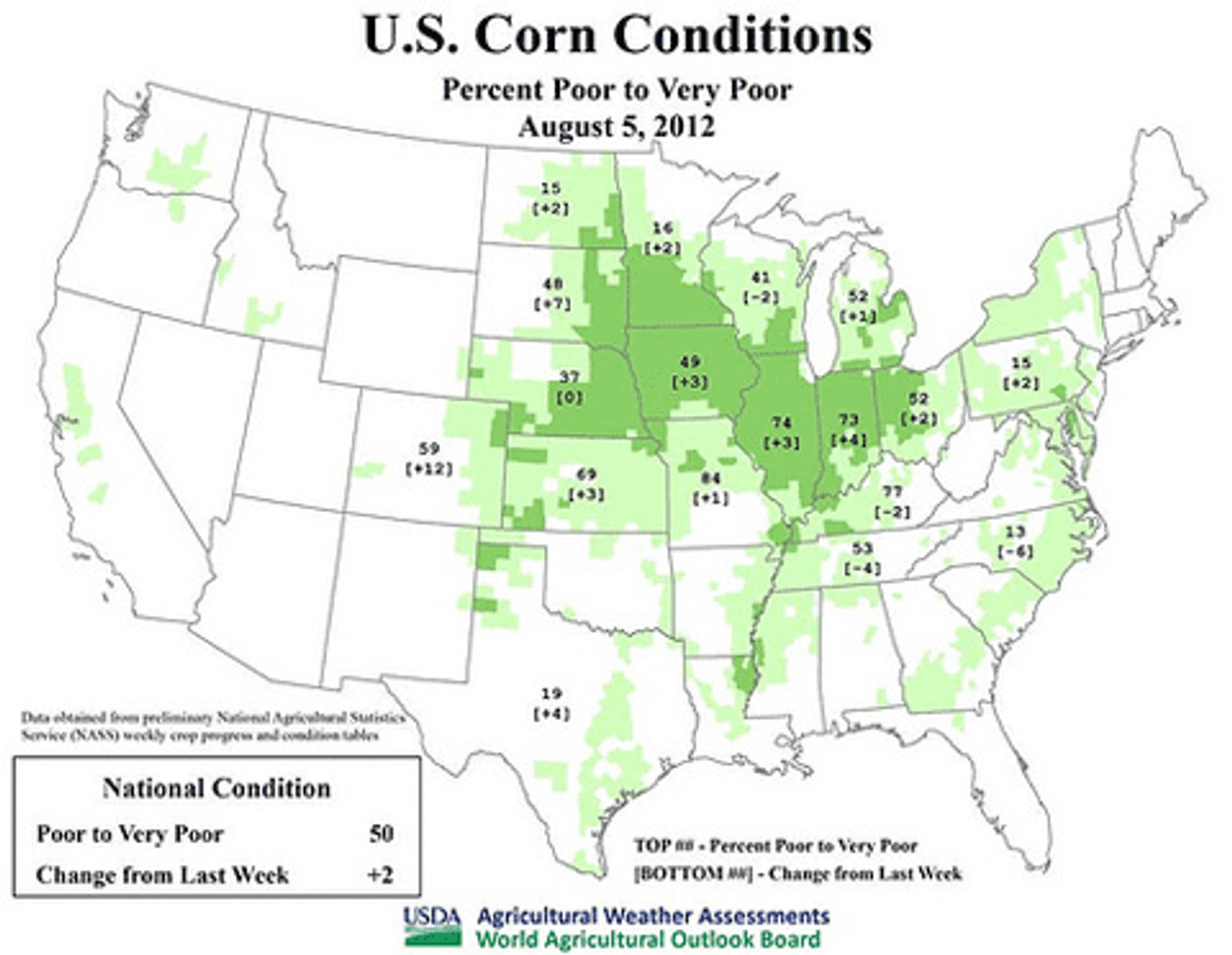Drought conditions extended across much of the US this week, intensifying in the western plains where temperatures averaged 10°F above normal. Oklahoma has been particularly severely affected.
Cooler temperatures and scattered rain across the Midwest have mitigated some of the drought damage to still maturing soybean crops, although the impact may be short-lived if more precipitation does not follow soon. Up to an inch of rain fell in the Corn Belt.
 Overall the year remains the driest in more than half a century and the hottest since recordkeeping began. The average temperature for July was 77.6°F, 0.2°F more than the previous record set in July 1936, one of the worst months of the Dust Bowl.
Overall the year remains the driest in more than half a century and the hottest since recordkeeping began. The average temperature for July was 77.6°F, 0.2°F more than the previous record set in July 1936, one of the worst months of the Dust Bowl.
Most other records set in the 1930s have also been broken, National Center for Atmospheric Research scientist Kevin Trenberth told LiveScience August 8. “By itself this is not such a major feat, but the fact that the first seven months of the year is the hottest on record is much more impressive from a climate standpoint, and highlights the fact that there is more than just natural variability playing a role,” he said. “Global warming from human activities has reared its head in a way that can only be a major warning for the future.”
Much of the western plains region is sweltering under triple-digit temperatures. In Oklahoma, in the past week, 18 different fires charred 94,000 acres, destroying more than 120 structures and killing at least one person. The Oklahoma medical examiner’s office was seeking dental records to identify the victim, found in the town of Norman. Residents who were forced to evacuate their homes described rapidly shifting “walls of flames” and “fire tornadoes.”
Oklahoma emergency response has been strained to the limit by the disaster. The Oklahoman reported Tuesday that Norman firefighters were working “20-plus hours” per shift.
The nation’s pastureland has been scorched by the drought and heat. The USDA rated 59 percent of all pasture and rangeland in the poorest condition, the worst the agency has ever recorded. USDA meteorologist Brad Rippey stated on the agency’s web site Monday that recovery from this state of affairs “will be a lengthy process, requiring the change of seasons and multiple soaking rainfall events—not just occasional showers.”
 For the week ending August 5, corn and soybean conditions stand at lows not seen since the drought of 1988. Fully 50 percent of the corn crop is now in “poor” or “very poor” condition, meaning that fields will bear little to no yield come harvest.
For the week ending August 5, corn and soybean conditions stand at lows not seen since the drought of 1988. Fully 50 percent of the corn crop is now in “poor” or “very poor” condition, meaning that fields will bear little to no yield come harvest.
Soybeans rated in the poorest categories account for 39 percent of total acreage surveyed by the US Department of Agriculture across 18 states. This is worse than the 1988 record of 37 percent poor to very poor soybean acreage.
Commodity Weather Group said on Wednesday that the drought would spread to impact the soybean, cotton, and rice crops of the southern Delta region along the Mississippi River: “Rain chances are slim in the Delta in the next five days, and stress continues to hinder crops in the northwestern half of the region, mainly in the double-crop soybeans in Arkansas, Mississippi, western Tennessee and western Kentucky.”
Commodities investors have jacked up grain prices on such news. Many analysts expect the USDA to downgrade its crop outlook for August on Friday to the lowest level in nearly two decades. Soybean inventories are projected to plummet to the lowest level in over 30 years.
A Dow Jones poll of analysts this week found the expectation that the USDA would cut its corn production estimates by 15.4 percent, mainly through the lowering of its per-acre yield estimate. Currently, the USDA forecasts a yield of 146 bushels per acre. Farmers and agricultural economists across the Midwest have surveyed crops and projected yields ranging from 125 bushels per acre to 40 or less. Other farmers, particularly in southern Indiana and Illinois, have reported total crop losses.
A forecast of tight corn stocks sent futures prices soaring to all-time highs in July. Some trade analysts have projected that corn will surpass $9 or even $10 per bushel in the coming months. In anticipation of the USDA report and the outcome of a Russian food security commission meeting Wednesday, trading on the Chicago Board of Trade was highly volatile. “In the absence of news,” one French futures dealer told Reuters, “operators are testing technical levels in Chicago, with $8 for corn and $9 for wheat.”
Russia’s wheat crop, also stricken by drought, will likely be significantly smaller than last year’s. The Russian government has denied that it will impose an export ban as it did in 2010. That protectionist measure exacerbated inflation in Egypt, the world’s largest wheat importer, and fed into the social unrest across the Middle East and North Africa that culminated in the Arab Spring of 2011. Current forecasts of the Russian wheat crop put it at 40.5 to 42.5 million tons—a harvest similar to the 41.5 million ton crop of 2010.
On August 6, International Food Policy Research Institute director general Shenggen Fan warned that famine and unrest would result from price spikes. Fan called for the US and Europe to curb the amount of corn destined for ethanol and biofuel production. Presently 40 percent of the US corn crop is guaranteed to the ethanol industry through a federal mandate.
“Poor and vulnerable groups in developing countries are hard hit by high and volatile prices of the agricultural commodities they depend on for their primary daily caloric intake,” Fan said. “As experienced during the 2007-08 global food crisis, price movements in domestic markets can have significant impacts on global markets, and vice versa.”
